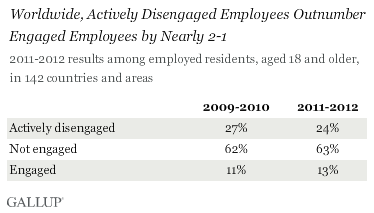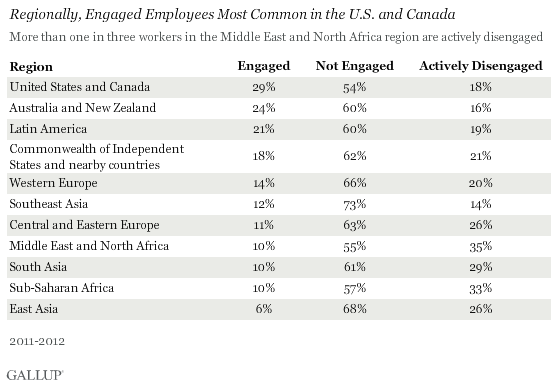WASHINGTON, D.C. -- Only 13% of employees worldwide are engaged at work, according to Gallup's new 142-country study on the State of the Global Workplace. In other words, about one in eight workers -- roughly 180 million employees in the countries studied -- are psychologically committed to their jobs and likely to be making positive contributions to their organizations.

The bulk of employees worldwide -- 63% -- are "not engaged," meaning they lack motivation and are less likely to invest discretionary effort in organizational goals or outcomes. And 24% are "actively disengaged," indicating they are unhappy and unproductive at work and liable to spread negativity to coworkers. In rough numbers, this translates into 900 million not engaged and 340 million actively disengaged workers around the globe.
The 13% of engaged employees in the 2011-2012 study has ticked upward from the 11% in Gallup's previous global workplace assessment, conducted in 2009-2010. Furthermore, the proportion who are "actively disengaged" has dipped from 27% to 24%. However, low levels of engagement among global workers continue to hinder gains in economic productivity and life quality in much of the world.
Engaged Workers Most Common in U.S. and Canada, Actively Disengaged in MENA
As in Gallup's previous employee study, engagement levels among employees vary across different global regions and among countries within those regions. At the regional level, Northern America (that is, the U.S. and Canada) have the highest proportion of engaged workers, at 29%, followed by Australia and New Zealand, at 24%.

Not all economically developed regions fare as favorably; across 19 Western European countries, 14% of employees are engaged, while a significantly higher 20% are actively disengaged. However, the highest proportions of actively disengaged workers are found in the Middle East and North Africa (MENA) and sub-Saharan Africa regions, at 35% and 33%, respectively.
The findings also reveal differences among employees with different job types and at different education levels within countries. Recognizing these differences can help managers understand how societal factors could affect workplace characteristics and help them identify specific barriers they must overcome to build more engaged workforces. See the full report for results by job type and education level.
Regardless of region or industry, businesses seeking to adapt to rapidly changing global economic conditions must learn how to maintain high-productivity workplaces and grow their customer bases in widely varying social, cultural, and economic environments. Systems for reliably measuring and improving employee engagement across industries and regions worldwide are vital to that goal.
Bottom Line
People spend a substantial part of their lives working, whether in a high-tech startup in Singapore, a financial institution in Australia, or a garment factory in the Dominican Republic. As a result, the quality of their workplace experience is inevitably reflected in the quality of their lives. Gallup's finding that the vast majority of employees worldwide report an overall negative experience at work -- and just one in eight are fully involved in and enthusiastic about their jobs -- is important when considering why the global recovery remains sluggish, while social unrest abounds in many countries.
Business leaders worldwide must raise the bar on employee engagement. Increasing workplace engagement is vital to achieving sustainable growth for companies, communities, and countries --- and for putting the global economy back on track to a more prosperous and peaceful future.
For complete data sets or custom research from the more than 150 countries Gallup continually surveys, please contact us.
Survey Methods
For the current workplace study, employee engagement results were collected among 73,752 respondents 18 and older in 141 countries via the Gallup World Poll, and 151,335 U.S. respondents using the Gallup Daily tracking survey. Employee engagement questions were asked only of those respondents who indicated they were employed for an employer, either full-time or part-time. Country-level results are weighted by population size to arrive at regional and global aggregates. For results based on the total global sample, one can say with 95% confidence that the margin of sampling error is less than ± 1 percentage point.
Country-level engagement data are reported only among the 94 countries in which at least 300 employed respondents were sampled. The table on page 2 contains those country-level results, along with the margin of sampling error associated with each percentage. The margin of error reflects the influence of data weighting. In addition to sampling error, question wording and practical difficulties in conducting surveys can introduce error or bias into the findings of public opinion polls.
Gallup measures employee engagement based on workers' responses to its Q12 survey, which consists of 12 actionable workplace elements with proven links to performance outcomes. To identify these elements, Gallup spent years conducting thousands of interviews at every level of various organizations, in most industries, and in several countries. Since Gallup finalized the Q12 question wording in the late 1990s, the survey has been administered to more than 25 million employees in 189 different countries and 69 languages. For a listing of the Q12 survey items and more information on how they relate to business performance outcomes, see the full State of the Global Workplace report.
For more complete methodology and specific survey dates, please review Gallup's Country Data Set details.

